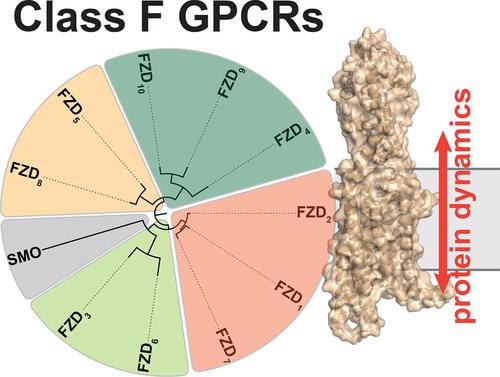当前位置:
X-MOL 学术
›
Pharmacol. Rev.
›
论文详情
Our official English website, www.x-mol.net, welcomes your
feedback! (Note: you will need to create a separate account there.)
International Union of Basic and Clinical Pharmacology CXV: The Class F of G Protein-Coupled Receptors
Pharmacological Reviews ( IF 19.3 ) Pub Date : 2024-11-01 , DOI: 10.1124/pharmrev.124.001062 Gunnar Schulte 1
Pharmacological Reviews ( IF 19.3 ) Pub Date : 2024-11-01 , DOI: 10.1124/pharmrev.124.001062 Gunnar Schulte 1
Affiliation

|
The class F of G protein-coupled receptors (GPCRs) consists of 10 Frizzleds (FZD1–10) and Smoothened (SMO). FZDs bind and are activated by secreted lipoglycoproteins of the Wingless/Int-1 (WNT) family, and SMO is indirectly activated by the Hedgehog (Hh) family of morphogens acting on the transmembrane protein Patched. The advance of our understanding of FZDs and SMO as dynamic transmembrane receptors and molecular machines, which emerged during the past 14 years since the first-class F GPCR IUPHAR nomenclature report, justifies an update. This article focuses on the advances in molecular pharmacology and structural biology providing new mechanistic insight into ligand recognition, receptor activation mechanisms, signal initiation, and signal specification. Furthermore, class F GPCRs continue to develop as drug targets, and novel technologies and tools such as genetically encoded biosensors and CRISP/Cas9 edited cell systems have contributed to refined functional analysis of these receptors. Also, advances in crystal structure analysis and cryogenic electron microscopy contribute to the rapid development of our knowledge about structure-function relationships, providing a great starting point for drug development. Despite the progress, questions and challenges remain to fully understand the complexity of the WNT/FZD and Hh/SMO signaling systems.
中文翻译:

国际基础和临床药理学联合会 CXV:G 蛋白偶联受体的 F 类
F 类 G 蛋白偶联受体 (GPCR) 由 10 个卷曲 (FZD1-10) 和平滑 (SMO) 组成。FZD 结合并被 Wingless/Int-1 (WNT) 家族分泌的脂糖蛋白激活,而 SMO 被作用于跨膜蛋白 Patched 的形态发生菌 Hedgehog (Hh) 家族间接激活。自一流的 F GPCR IUPHAR 命名报告发布以来的过去 14 年中,我们对 FZD 和 SMO 作为动态跨膜受体和分子机器的理解取得了进展,这证明了更新的合理性。本文重点介绍分子药理学和结构生物学的进展,为配体识别、受体激活机制、信号起始和信号规范提供了新的机制见解。此外,F 类 GPCR 继续作为药物靶点发展,基因编码生物传感器和 CRISP/Cas9 编辑细胞系统等新技术和工具有助于对这些受体进行精细化功能分析。此外,晶体结构分析和低温电子显微镜的进步有助于我们关于结构-功能关系的知识的快速发展,为药物开发提供了一个很好的起点。尽管取得了进展,但要充分理解 WNT/FZD 和 Hh/SMO 信号转导系统的复杂性仍然存在问题和挑战。
更新日期:2024-10-16
中文翻译:

国际基础和临床药理学联合会 CXV:G 蛋白偶联受体的 F 类
F 类 G 蛋白偶联受体 (GPCR) 由 10 个卷曲 (FZD1-10) 和平滑 (SMO) 组成。FZD 结合并被 Wingless/Int-1 (WNT) 家族分泌的脂糖蛋白激活,而 SMO 被作用于跨膜蛋白 Patched 的形态发生菌 Hedgehog (Hh) 家族间接激活。自一流的 F GPCR IUPHAR 命名报告发布以来的过去 14 年中,我们对 FZD 和 SMO 作为动态跨膜受体和分子机器的理解取得了进展,这证明了更新的合理性。本文重点介绍分子药理学和结构生物学的进展,为配体识别、受体激活机制、信号起始和信号规范提供了新的机制见解。此外,F 类 GPCR 继续作为药物靶点发展,基因编码生物传感器和 CRISP/Cas9 编辑细胞系统等新技术和工具有助于对这些受体进行精细化功能分析。此外,晶体结构分析和低温电子显微镜的进步有助于我们关于结构-功能关系的知识的快速发展,为药物开发提供了一个很好的起点。尽管取得了进展,但要充分理解 WNT/FZD 和 Hh/SMO 信号转导系统的复杂性仍然存在问题和挑战。































 京公网安备 11010802027423号
京公网安备 11010802027423号